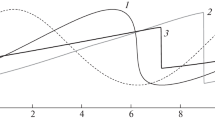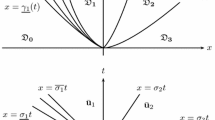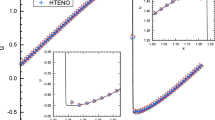Abstract
A comparative analysis of the accuracy of shock-capturing schemes, such as the RBM (Rusanov–Burstein–Mirin), CWA (Compact high order Weak Approximation), and A-WENO (Alternative Weighted Essentially Non-Oscillatory) schemes is carried out by numerically solving a gas-dynamic Cauchy problem with smooth periodic initial data. It is shown that, in the presence of shock waves, the RBM and CWA schemes (which do not involve nonlinear flux correction) have a higher order of integral convergence, which provides significantly higher accuracy to these schemes (compared to A-WENO) in areas of shock wave influence, despite the noticeable nonphysical oscillations at their fronts. This makes it possible to use the RBM and CWA schemes as basic ones in constructing combined schemes that monotonically localize shock fronts and, at the same time, maintain higher order accuracy in shock influence areas.



Similar content being viewed by others
REFERENCES
S. K. Godunov, “A difference method for numerical calculation of discontinuous solutions of the equations of hydrodynamics,” Mat. Sb. 47 (3), 271–306 (1959).
B. Van Leer, “Toward the ultimate conservative difference scheme: V. A second-order sequel to Godunov’s method,” J. Comput. Phys. 32 (1), 101–136 (1979). https://doi.org/10.1016/0021-9991(79)90145-1
A. Harten, “High resolution schemes for hyperbolic conservation laws,” J. Comput. Phys. 49 (3), 357–393 (1983). https://doi.org/10.1016/0021-9991(83)90136-5
G. S. Jiang and C. W. Shu, “Efficient implementation of weighted ENO schemes,” J. Comput. Phys. 126, 202–228 (1996). https://doi.org/10.1006/jcph.1996.0130
B. Cockburn, “An introduction to the discontinuous Galerkin method for convection-dominated problems, advanced numerical approximation of nonlinear hyperbolic equations,” Lect. Notes Math. 1697, 150–268 (1998). https://doi.org/10.1007/BFb0096353
S. A. Karabasov and V. M. Goloviznin, “Compact accurately boundary-adjusting high-resolution technique for fluid dynamics,” J. Comput. Phys. 228, 7426–7451 (2009). https://doi.org/10.1016/j.jcp.2009.06.037
S. Karni, A. Kurganov, and G. Petrova, “A smoothness indicator for adaptive algorithms for hyperbolic systems,” J. Comput. Phys. 178, 323–341 (2002). https://doi.org/10.1006/jcph.2002.7024
A. G. Kulikovskii, N. V. Pogorelov, and A. Yu. Semenov, Mathematical Aspects of Numerical Solution of Hyperbolic Systems (Fizmatlit, Moscow, 2001; Chapman and Hall/CRC, London, 2001).
R. J. LeVeque, Finite Volume Methods for Hyperbolic Problems (Cambridge Univ. Press, Cambridge, 2002). https://doi.org/10.1017/CBO9780511791253
E. F. Toro, Riemann Solvers and Numerical Methods for Fluid Dynamics: A Practical Introduction (Springer, Berlin, 2009). https://doi.org/10.1007/b79761
V. V. Ostapenko, “Convergence of finite-difference schemes behind a shock front,” Comput. Math. Math. Phys. 37 (10), 1161–1172 (1997).
J. Casper and M. H. Carpenter, “Computational consideration for the simulation of shock-induced sound,” SIAM J. Sci. Comput. 19 (3), 813–828 (1998). https://doi.org/10.1137/S1064827595294101
S. Chu, O. A. Kovyrkina, A. Kurganov, and V. V. Ostapenko, “Experimental convergence rate study for three shock-capturing schemes and development of highly accurate combined schemes,” Numer. Methods Part. Differ. Equations 5, 4317–4346 (2023). https://doi.org/10.1002/num.23053
O. A. Kovyrkina and V. V. Ostapenko, “On the practical accuracy of shock-capturing schemes,” Math. Models Comput. Simul. 6 (2), 183–191 (2014). https://doi.org/10.1134/S2070048214020069
N. A. Mikhailov, “The convergence order of WENO schemes behind a shock front,” Math. Models Comput. Simul. 7 (5), 467–474 (2015). https://doi.org/10.1134/S2070048215050075
O. A. Kovyrkina and V. V. Ostapenko, “On the construction of combined finite-difference schemes of high accuracy,” Dokl. Math. 97 (1), 77–81 (2018). https://doi.org/10.1134/S1064562418010246
N. A. Zyuzina, O. A. Kovyrkina, and V. V. Ostapenko, “Monotone finite-difference scheme preserving high accuracy in regions of shock influence,” Dokl. Math. 98 (2), 506–510 (2018). https://doi.org/10.1134/S1064562418060315
M. E. Ladonkina, O. A. Neklyudova, V. V. Ostapenko, and V. F. Tishkin, “Combined DG scheme that maintains increased accuracy in shock wave areas,” Dokl. Math. 100 (3), 519–523 (2019). https://doi.org/10.1134/S106456241906005X
M. D. Bragin and B. V. Rogov, “On the accuracy of bicompact schemes as applied to computation of unsteady shock waves,” Comput. Math. Math. Phys. 60 (5), 864–878 (2020). https://doi.org/10.1134/S0965542520050061
O. A. Kovyrkina, A. A. Kurganov, and V. V. Ostapenko, “Comparative analysis of the accuracy of three different schemes in the calculation of shock waves,” Math. Models Comput. Simul. 15 (3), 401–414 (2023). https://doi.org/10.1134/S2070048223030092
M. D. Bragin, O. A. Kovyrkina, M. E. Ladonkina, V. V. Ostapenko, V. F. Tishkin, and N. A. Khandeeva, “Combined numerical schemes,” Comput. Math. Math. Phys. 62 (11), 1743–1781 (2022). https://doi.org/10.1134/S0965542522100025
V. V. Rusanov, “Third-order accurate shock-capturing schemes for computing discontinuous solutions,” Dokl. Akad. Nauk SSSR 180 (6), 1303–1305 (1968).
S. Z. Burstein and A. A. Mirin, “Third order difference methods for hyperbolic equations,” J. Comput. Phys. 5 (3), 547–571 (1970). https://doi.org/10.1016/0021-9991(70)90080-X
V. V. Ostapenko, “Construction of high-order accurate shock-capturing finite-difference schemes for unsteady shock waves,” Comput. Math. Math. Phys. 40 (12), 1784–1800 (2000).
B.-S. Wang, W. S. Don, A. Kurganov, and Y. Liu, “Fifth-order A-WENO schemes based on the adaptive diffusion central-upwind Rankine–Hugoniot fluxes,” Commun. Appl. Math. Comput. 5, 295–314 (2023). https://doi.org/10.1007/s42967-021-00161-2
Funding
The research in Sections 4–7 was supported by the Russian Science Foundation, project no. 22-11-00060.
Author information
Authors and Affiliations
Corresponding author
Ethics declarations
The authors of this work declare that they have no conflicts of interest.
Additional information
Translated by I. Ruzanova
Publisher’s Note.
Pleiades Publishing remains neutral with regard to jurisdictional claims in published maps and institutional affiliations.
Rights and permissions
About this article
Cite this article
Ostapenko, V.V., Polunina, E.I. & Khandeeva, N.A. On the Integral Convergence of Numerical Schemes Calculating Gas-Dynamic Shock Waves. Dokl. Math. 108, 374–381 (2023). https://doi.org/10.1134/S1064562423701260
Received:
Revised:
Accepted:
Published:
Issue Date:
DOI: https://doi.org/10.1134/S1064562423701260




